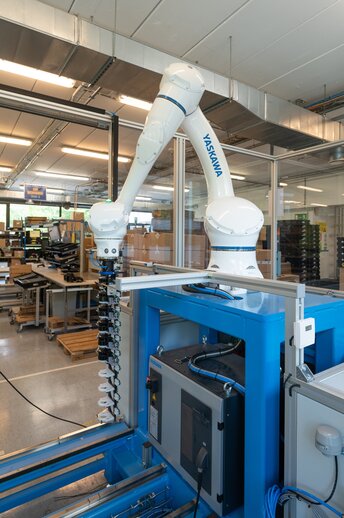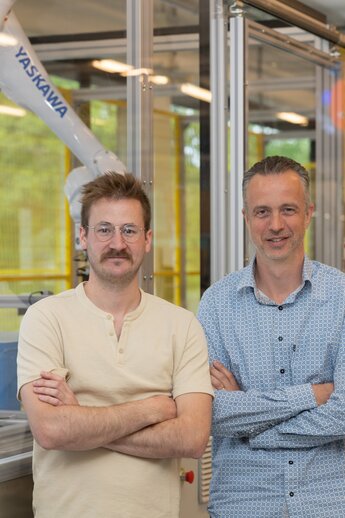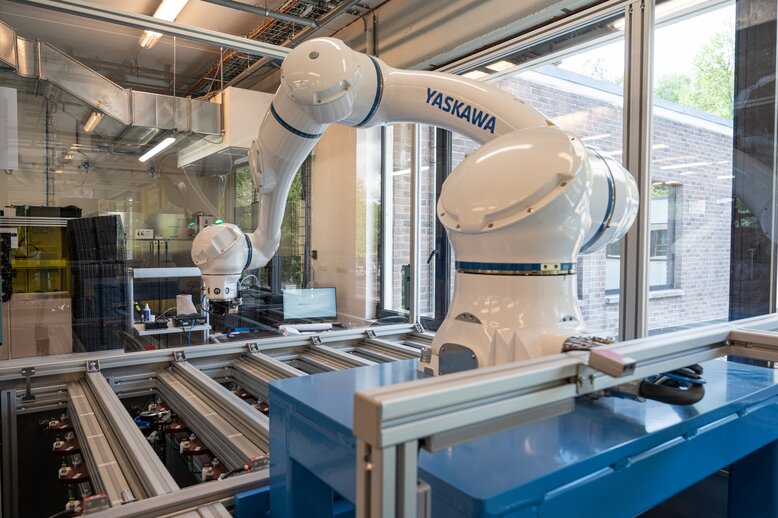Unser umfangreiches Robotersortiment bietet neben anwendungsbezogenen Varianten wie Schweiss-, Palettier-, Lackier- und Handling-Roboter auch Modelle für Labor- und Reinraumapplikationen sowie schlüsselfertige automatisierte Schweißsysteme höchster Qualität.
Cobot cell provides 24/7 calibration and quality inspection of sensors
We don't dwell on it. But there is a lot involved in making doors open automatically. Fortunately, the more than 600 employees at BEA Sensors do. And how. Headquartered in Angleur (near Liège), the company can call itself a pioneer in this niche market and remains constantly committed to innovation. To further guarantee the impeccable quality of its products, BEA recently invested in a new test rig. The heart of this cell is the Yaskawa HC20DTP cobot. "It gave us the flexibility we were looking for," sums up Industrialization manager Sébastien Simonis.
When BEA, bureau d'electronique appliqué, was founded in '65, nothing hinted at what a global player it would grow into. "Back then the focus was still on general electronics, but the management already had a feeling that detection was becoming increasingly important. Already in '72, the first sensor for security was developed, a global first and the path on which we have gone further and further," explains Sébastien. Since then, BEA has been building a full line for access control, and safety and security systems for industry, security and transportation. To this day, innovation is the company's trademark. And although BEA now operates worldwide with production sites in Pittsburgh and Beijing, the bulk of R&D still happens in Angleur. "Our heart is here. That may not sound like something you would expect from a technology player, but it really is the people who make the company," says Sébastien.
- Branchen
- Elektronische Produkte
- Anwendungsmöglichkeiten
- Qualitätskontrolle
- Kunde
- BEA
- Produkte
- HC20DTP - HC-Serie
Innovation hand in hand with quality
It has earned BEA a reputation as a pioneer. A reputation it also reaffirms with each innovation. A good example is the ORASCAN, which was recently launched at the BAU fair. Sébastien: "For a sliding door to work smoothly, safely and reliably, you needed three separate sensors, often a combination of infrared and radar technology. With the introduction of the ORASCAN, you can now control the entire door with a single device. After all, we have succeeded in making laser technology a whole lot more accurate and integrating it with radar technology." So it should come as no surprise that this innovation received particularly high marks at the fair. "As soon as the ORASCAN is commercially available, our production has to be ready for it. But so does our quality control, because each product is thoroughly tested here before it leaves for the customer," Sébastien stresses.
More flexibility in calibration and quality inspection
The Industrialization team therefore came up with a new test setup. Whereas in the past they invariably opted for specific, product-tailored installations, this time they wanted to change tack and make their own production future-proof. "The idea was to work with a robotic cell for calibration and quality inspection that could flexibly adapt to the different shape and dimensions of new and existing products and continue to work autonomously 24/7." The heart of the cell was to be a six-axis cobot with sufficient payload to provide the necessary flexibility in that area as well. A search that quickly led them to Yaskawa because with its Motoman HC series, it sets the standard in the cobot market in this regard. "They have the biggest," Gilles Bauduin, technical support and designer Industrialization, tells me with a wink. "Besides, I knew from experience at my previous employer how reliable they work."
Racks: standard connection, custom design
Even for BEA this was still largely unexplored territory, which they enthusiastically set their sights on with the entire Industrialization team. Gilles: "The only robot that is already in production here is a four-axis robot. This challenge was of a completely different order. After all, we had to build the cell in such a way that the cobot could reach every gripping position and get back to its starting point in a smooth, logical way." Fortunately, Sébastien's team could count on a lot of support from Yaskawa. The cobot was delivered and installed on its pedestal as early as 2020. "However, due to corona, we had to put the project on hold. A year ago it was picked up again." First, the rack was designed, built and fitted into the cell. Finally, together with the cobot, the racks are the key to flexibility. "The racks have a standard connection, so the cobot can easily grab them. But underneath, the design can be adapted according to the product to be tested." With room for 10 sensors per rack and 30 racks, 300 products can thus be loaded for quality inspection.
Confidence refueled
Today, the R&D team is already putting the cobot through its paces. "The ramp-up has begun and we are confident that once the production of our ORASCAN gets under steam he will be able to follow smoothly." He has also already proven himself in terms of flexibility. "He makes it very easy to further fine-tune the design of products and then immediately subject them to the necessary quality inspection. Even if the dimensions differ by more than 10 mm, I only need to adjust one line in the programming to get the cobot to work reliably." The best proof of its ability is that the cell has already received an exact copy in the meantime, raising its testing capacity to 600. In addition, BEA and Yaskawa are looking together at how to integrate a robot into production so that when producing another new product, the ARTEK sensors, the glue can be laid down in a very controlled manner. "A solid foundation of trust has been established with this project," concludes Sébastien.






















